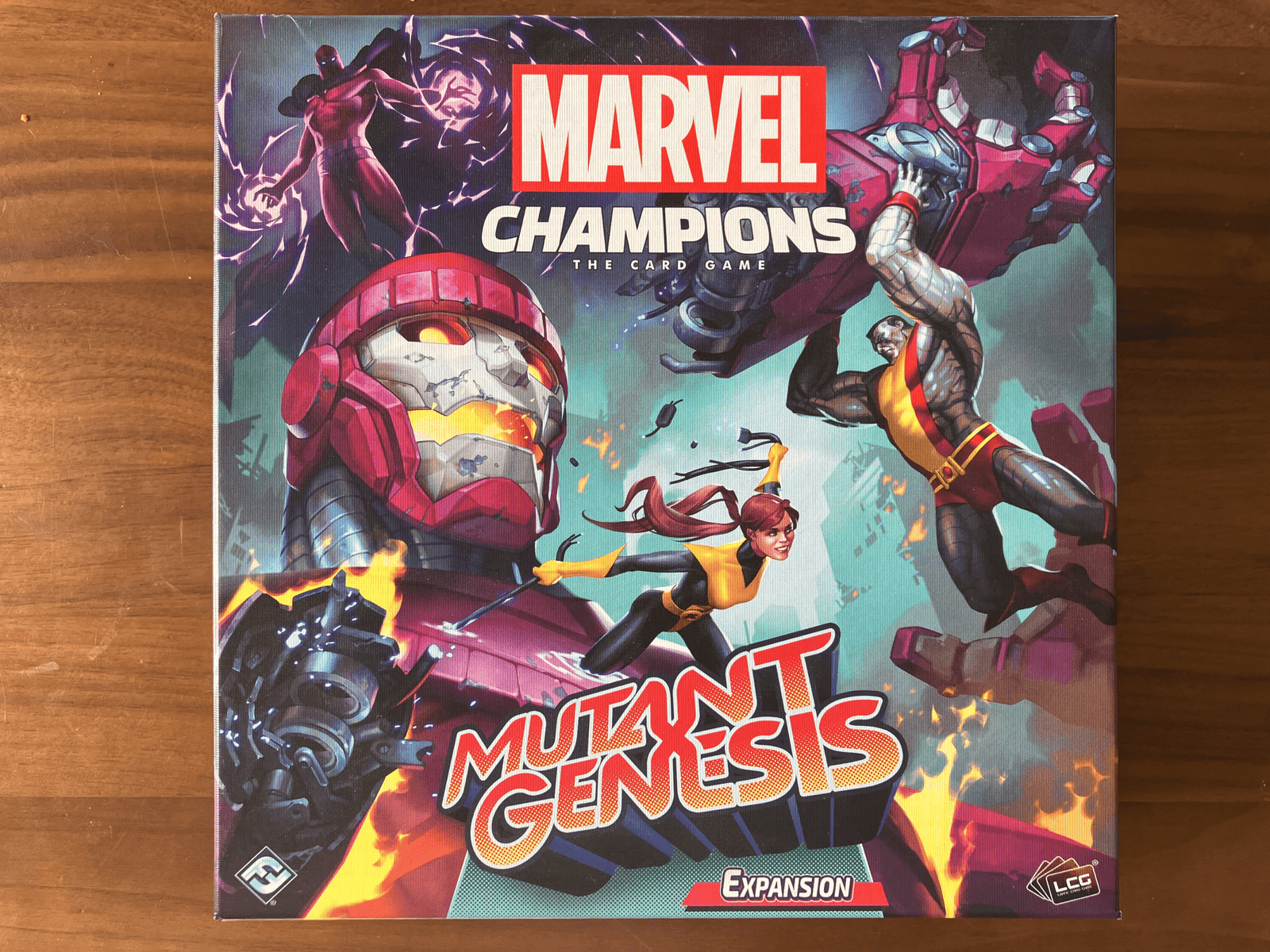
The X-men have finally come to Marvel Champions! Immerse yourself in brand new stories and challenges in the exciting world of “Mutant Genesis.” Face off against iconic villains with your favorite X-men heroes, which all bring fresh new mechanics and ideas to the game. As a dedicated Marvel Champions enthusiast or a fan of the X-men, this is (probably) the one you’ve been waiting for. Let’s dive into a detailed exploration of the Marvel Champions Mutant Genesis expansion – another quality chapter in the Marvel Champions universe that (spoiler alert) deserves the hype.
Introduction: A Brief Overview of Marvel Champions
Marvel Champions Stands is a Living Card Game (LCG) where players step into the shoes of Marvel’s superheroes (and their alter-egos) each with a unique deck tailored to their distinct abilities and story arcs. These Champions must cooperate to thwart the villains’ nefarious schemes and save the day, drawing upon their collective might and strategic prowess.
One of the great things about Marvel Champions, as opposed to other Living Card games, is that players can jump right in, using the prebuilt hero decks, that come ready to go in any pack you buy – no deck construction required. Then, if you choose, you can use their card pool to build decks that further enhance the abilities of these heroes. So it can provide enjoyment for a lot of different types of players.
But the best thing about Marvel Champions lies in its continued evolution; with every expansion, the characters and options expand, introducing new dynamics and challenges. Its unique blend of continuous content updates, thematic appeal, and accessibility keeps Marvel champions as compelling as the day it came out.
Marvel Champions Mutant Genesis Expansion
Mutant Genesis is a testament to giving fans what they’ve craved – a deep dive into the X-Men universe – complete with five brand new scenarios and two new playable heroes, Colossus and Shadowcat. You’ll encounter LOTS of sentinels, protect Senator Kelly and Jubilee, and end up in an epic final duel with Magneto. Suffice it to say, the theme here is very well executed – richly detailed and carefully crafted, guaranteeing that your foray into the world of mutants is filled with a wealth of thematic delights.
What’s In The Box?
Heroes
Shadowcat
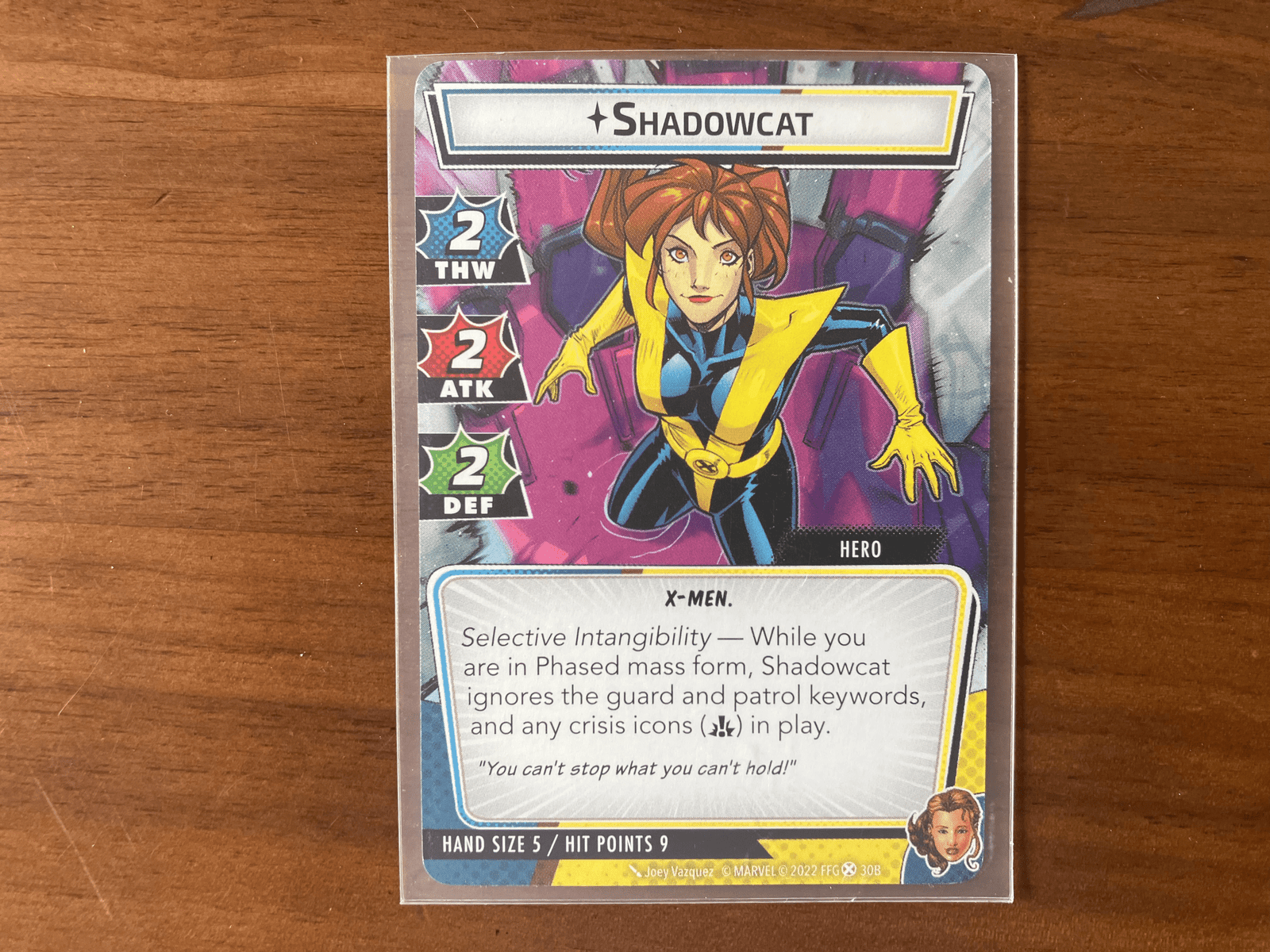
Shadowcat has some very interesting ideas in her kit mainly based around switching between her Phased and Solid forms. It is not that dissimilar from Vision’s mechanics, but this takes it to the next level. When you are Phased you cannot take any damage and you can also ignore guard and crisis keywords, but your solid form gives you an additional resource for an attack event.
Getting the timing right is a fun challenge, because, unlike with Vision, you don’t get to choose when you change forms. You change automatically based on certain triggers. So if you get it right, you can avoid taking any damage and then hit the villain hard. But, if you’re not careful, you might just take a big undefended hit to the face.
She comes with an aggression deck, which I immediately swapped out for protection, as it plays to her strengths. You can optimize for playing responses that trigger the villain’s turn, which is a very effective deck. The only downside here is that she’s so good in protection, that it doesn’t make much sense to play her in other aspects, which will likely reduce her appeal over time. But it is a very fun deck to pilot and manages to feel really fresh, despite borrowing a bit from other heroes.
Colossus
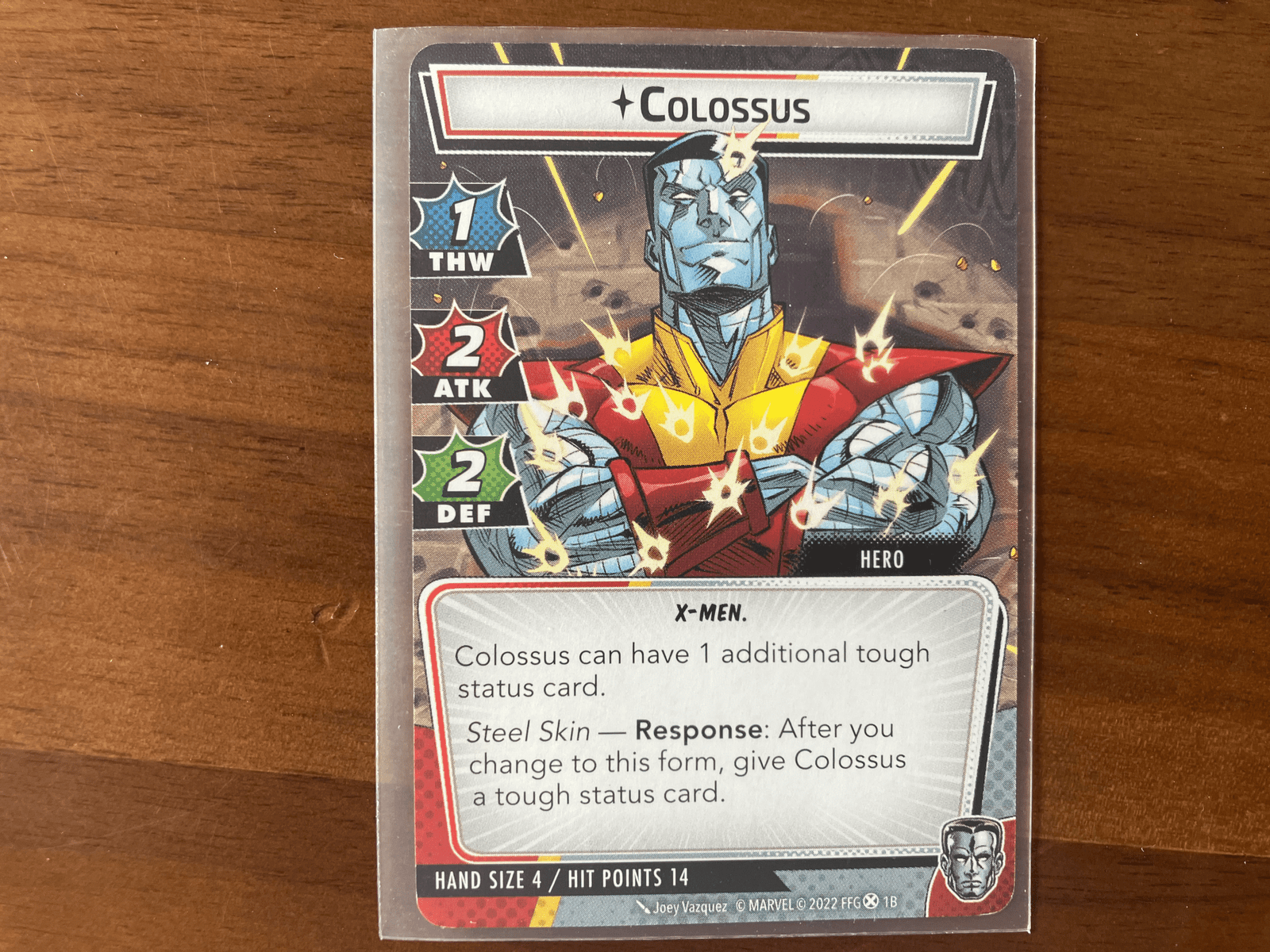
Colossus, on the other hand, feels entirely unique since his whole kit is built around tough status cards – which, of course, feels really thematic. Unlike any other hero in the game, he can have two tough status cards on himself in hero mode and he can spend those tough status cards to play the powerful attack cards in his kit.
He has a really weak hand size in hero form and terrible thwart options (making him particularly challenging in true solo) but once you get his kit set up, he starts to get a lot of extra card draw and puts out a lot of damage.
Careful not to run out of tough status cards though, or you’ll be facing a dead turn. Definitely a hero who benefits greatly from flipping to alter-ego – every turn if possible – which again, makes him challenging in true solo, but an interesting hero with potential in multiple aspects.
New Villainous Foes and Nefarious Plots
In the Mutant Genesis box, there are five scenarios that offer unique challenges:
Sabertooth
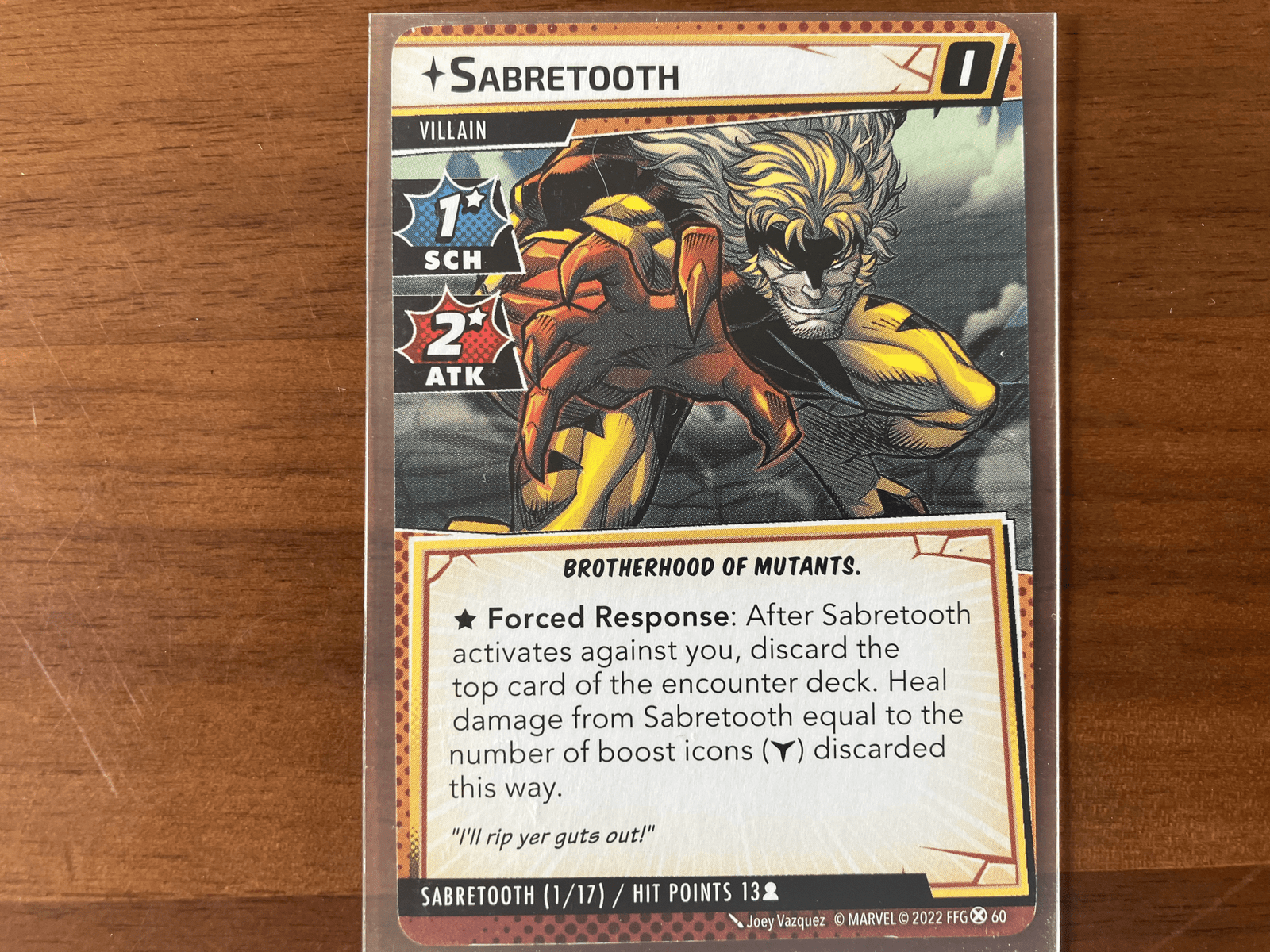
This scenario has a lot going on. You have to rescue and protect Senator Kelly from villain attacks. You’ll need to fend off Mystique who continually reappears – guarding Sabertooth and sneakily adding encounter cards into your deck that have annoying effects, including reducing your functional hand size. All while fending off a villain who hits hard and keeps healing himself.
It’s a long, brutal scenario and, though it makes sense thematically as the opening scenario, it really is a tempo killer in terms of difficulty. I would have preferred to see this later in the campaign – probably in the lead-up to Magneto.
That doesn’t mean it isn’t good, in fact, as long as I’m in the mood for an intense battle, this is a great one. Very tough, but fair. Just make sure you’ve got some time, because in a game where you win by reducing the villain’s health, if that villain with a healing factor that has consistency. reappearing a minion that prevents you from attacking him, can drag on a bit.
Project Wideawake – Night of the Sentinels
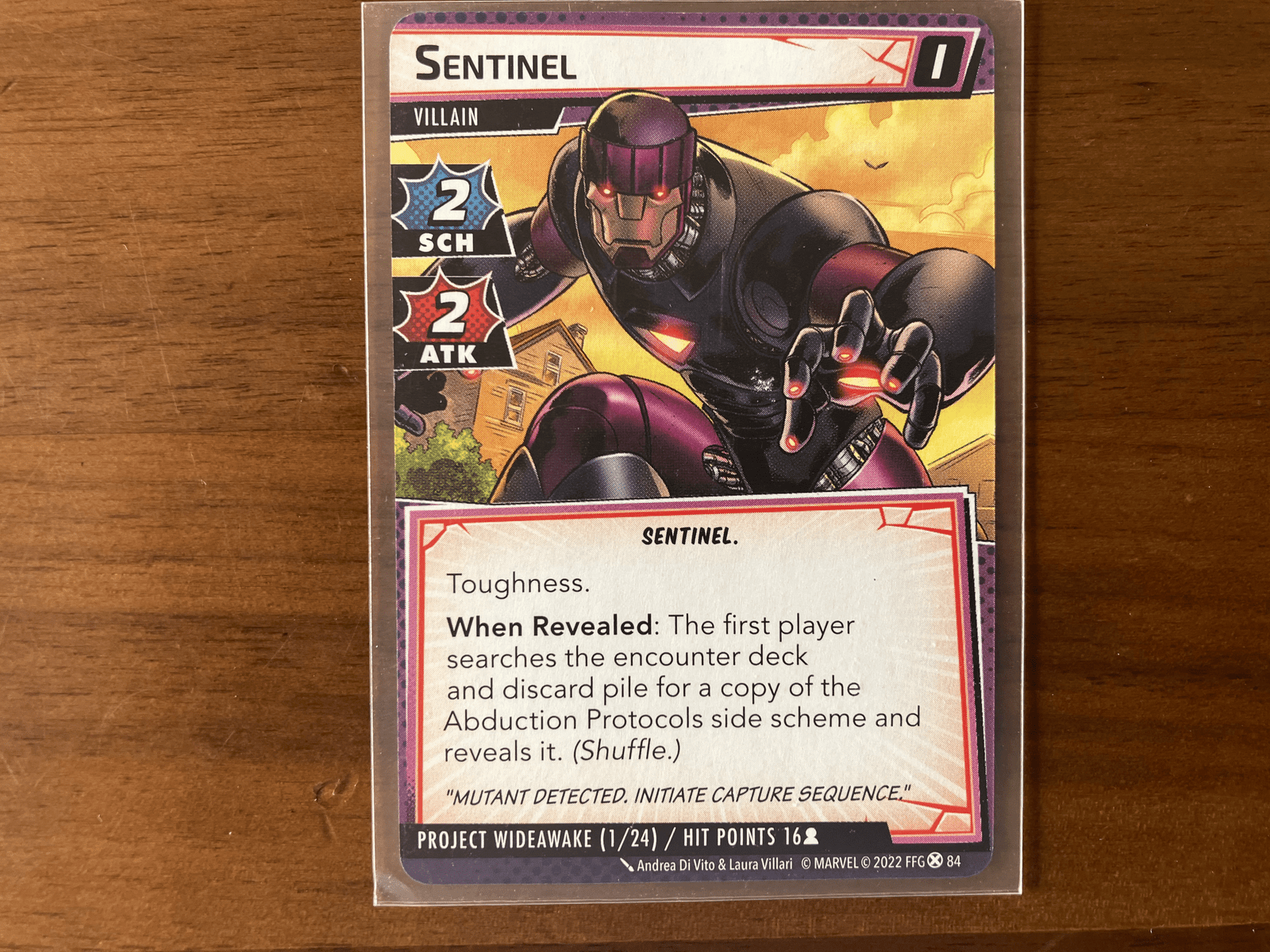
One of the problems with Marvel Champions is how strong the strategy of putting out a lot of allies and using them to chump-block villain attacks has become. This is because even the biggest villain attack can be absorbed by a dying ally, even if that ally only had one remaining health.
The designers have tried a couple of different strategies to discourage this – giving villains overkill or using indirect damage, and – in perhaps the worst scenario in the game – the collector who “collects” cards that leave play. This included allies, sure, but also anything else. This was too far, but it turns out, it was the first pass at an excellent solution.
In Project Wideawake you face off against an endless stream of sentinels, trying to capture as many mutants as they can. This was the perfect thematic opportunity to revisit the collector mechanic, but focus it solely on chump-blocking allies. Makes sense; you can’t send Jubilee out by herself, or she’ll be captured.
Is this the most interesting scenario in the game? No, just feels like a basic minion-heavy scenario, but it is the absolute best way we’ve seen of discouraging what has become an overpowered strategy. Applause to the designers on this one.
Master Mold
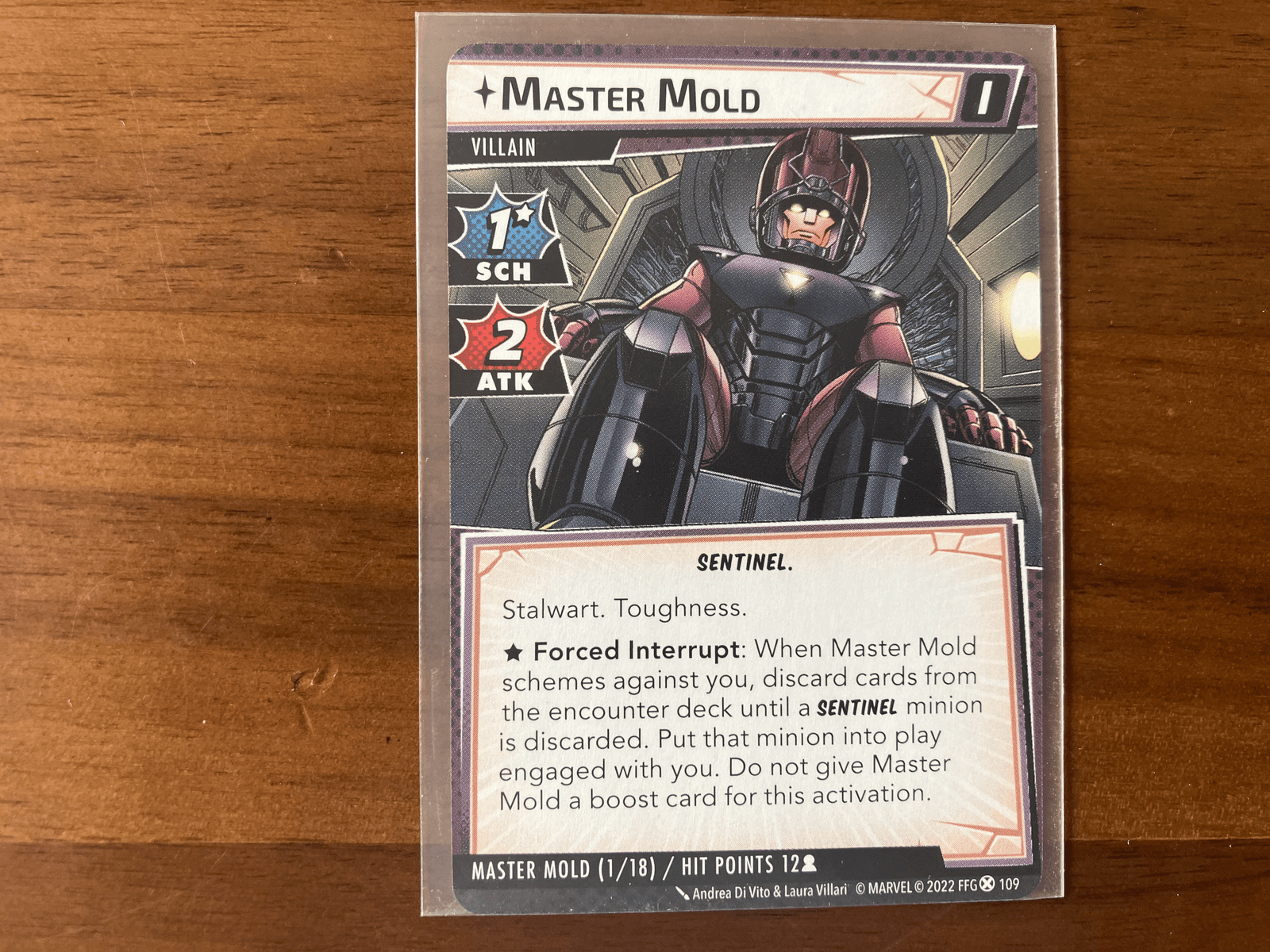
Master Mold again focuses on putting out a ton of sentinels but this time with intense attachments and guard. Good thing you have Magento as a (short-lived) metal-crushing ally.
Feels a bit like Zola, from the Red Skull box, and shows the growth in design, because it feels much more balanced than that scenario.
But, ultimately, this scenario suffers greatly from feeling VERY similar to the previous one. Unless I am specifically looking at these two side by side, I CANNOT keep them straight – thematically or mechanically. So while they are both, fine minion-heavy scenarios with some interesting ideas, they suffer from being two very similar scenarios, played one after the other.
Mansion Attack
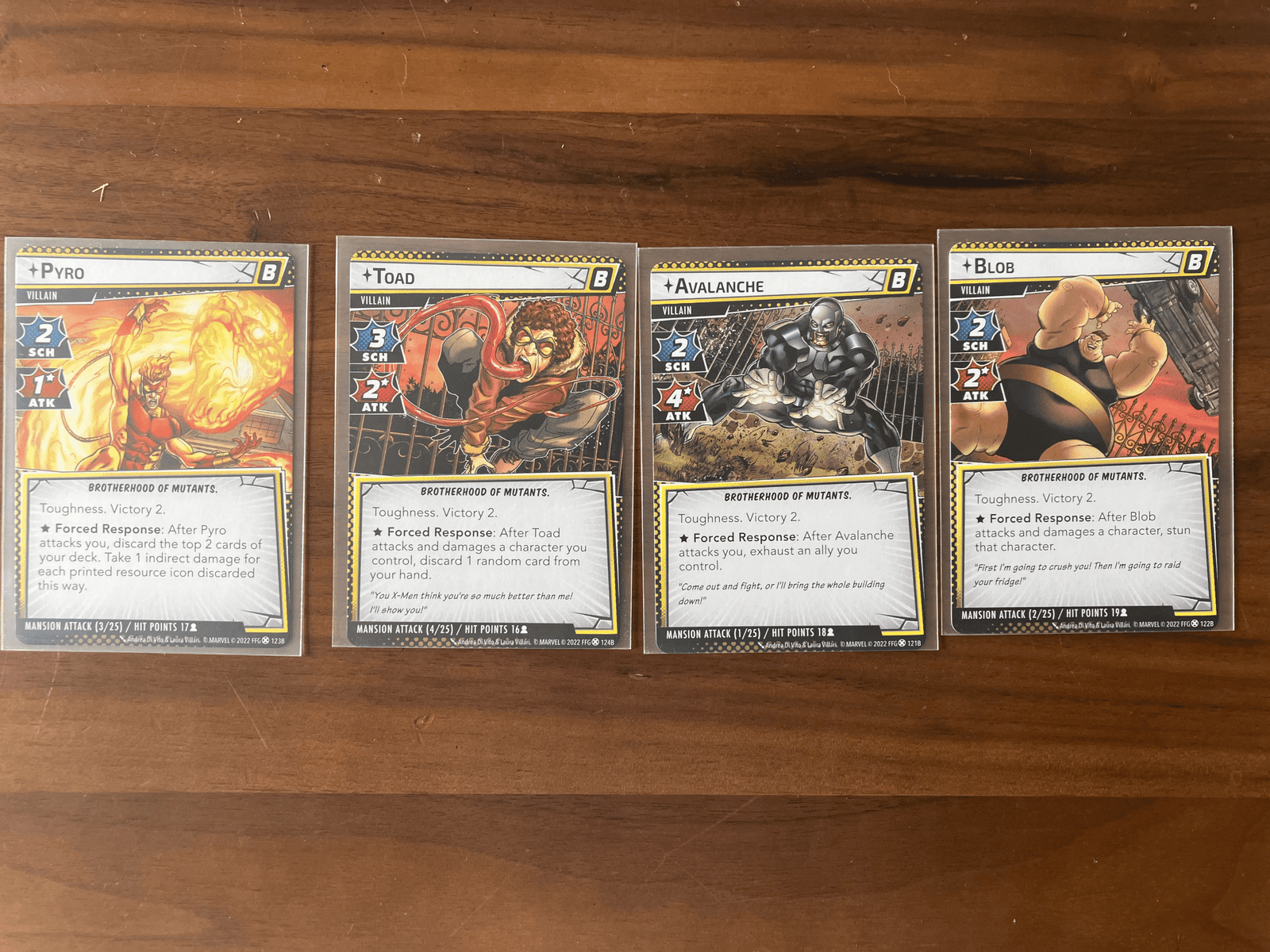
I think they finally got facing off against multiple villains right? We’ve seen this a few times now, each better than the last – Wrecking Crew, Tower Defense, the Sinister Six. But here, instead of putting out multiple primary villains at the same time, the members of the Brotherhood of Mutants each take a turn in the spotlight as the main villain.
But the great move here is that they are all included as high-powered minions in the deck, with multiple encounter cards that bring them into play. This is a vast improvement because now these villains can all be in play and can all activate and can really feel like they are working together to take down the heroes, rather than just taking turns punching.
It isn’t terribly difficult. And none of the multiple villain scenarios ever has been, but, in general, the other ones were quite easy because you could game the mechanics. This one feels like a good, fair showdown where you are taking on a team of villains. This one bodes well for the future of the game.
Magneto
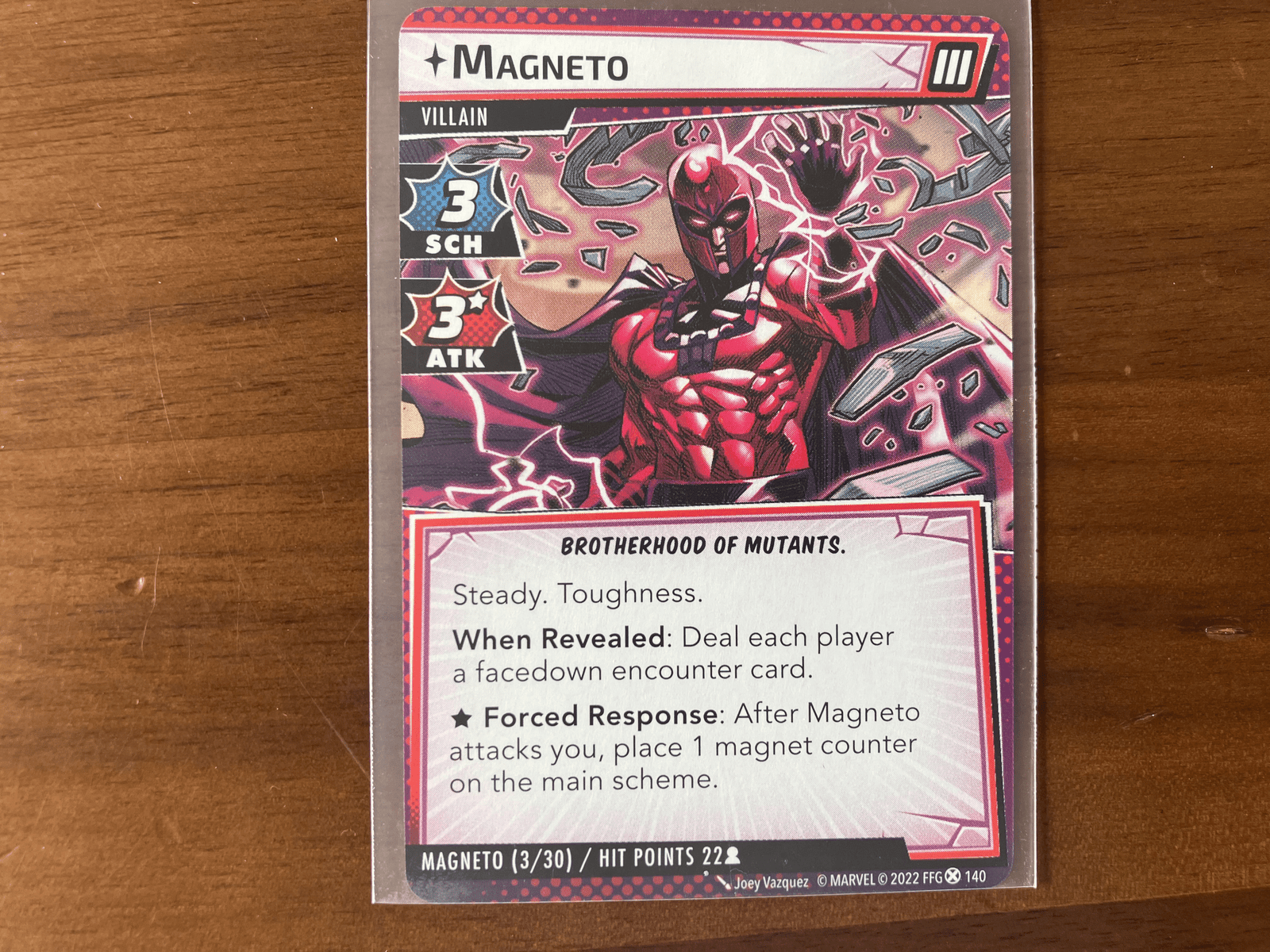
People in the Marvel Champions community have often praised Hela as being the most thematic experience in Marvel Champions, leading you through a narrative, with different levels and challenges, and a real feeling of progression. And I agree. It was a triumph.
Magneto picks up right where Hela left off, and gives us a really challenging, but fair villain, that requires us to progress through a narrative, in the form of side schemes, before we can reduce Magneto’s health past a certain threshold.
Requiring players to progress through a narrative is a great move on the designer’s part and while the theme isn’t entirely as rich as what we got with Hela, the mechanics and feeling of progression, are all wrapped up in a tight boss fight against a formidable opponent.
This is the best final boss fight in Marvel Champions, so far. Not brutally unfair or swingy like Ronan, Loki, and Venom Goblin. But challenging and grueling, in a way that rewards good play and punishes bad choices. I like those harder villains, don’t get me wrong, but in my opinion, as designed, they got it about perfect with this one.
Campaign: A Cohesive Narrative
The campaign is done very well here. It feels relevant, rather than tacked on, and links the scenarios together nicely. It does come together as an actual story, which has been a challenge with other campaigns. I do like that they add additional challenges, which, if you engage with them, give you additional benefits and, what I really like, is if you don’t engage with them they have negative consequences that carry through the rest of the campaign. It’s a much more interesting decision space than just focusing on earning positive benefits.
I also really liked the Days of Future past set being added in as you go along. It reminded me of the Badoon Headhunter set from Galaxy’s Most Wanted. People don’t talk much about that, because that box was already so difficult, but it was a cool idea to have this extra, thematic challenge going on in the background, that escalates over the course of the campaign. It’s easier to get excited about it in this box since there aren’t as many brutally punishing elements here, and I’m glad to see it revisited.
Conclusion: A New Dawn for Marvel Champions In Mutant Genesis
Mutant Genesis breathes new life into Marvel Champions, offering a compelling extension of the game’s universe that is rich in design, detail, and narrative. The designers brought their A-game with this one and though there are a couple of misteps (namely the difficulty of the first scenario and the similarity between the two sentinel scenarios) this one is very easy for me to recommend. One of the most solidly strong boxes in the game and one I definitely recommend as a first big box expansion – particularly if you are an X-men fan.
For seasoned players, it’s an opportunity to rekindle your passion for the game with fresh challenges and stories and to expand your card pool. For newcomers, I do think it is an excellent jumping-on point, offering a glimpse of what awaits them within the expanding universe of Marvel Champions.
We earn a commission if you make a
purchase, at no additional cost to you.
For more Marvel Champions content check out our comprehensive list of expansions with links to all our reviews.
Frequently Asked Questions (FAQ)
Q1: What is the Marvel Champions: Mutant Genesis expansion?
A: Mutant Genesis is an expansion to the Marvel Champions card game that introduces new heroes, villains, and game mechanics, all steeped in the X-Men universe’s lore and aesthetic.
Q2: Do I need the original Marvel Champions game to play the Mutant Genesis expansion?
A: Yes, the Mutant Genesis expansion is not a standalone game. It requires the core Marvel Champions game to play.
Q3: How does Mutant Genesis affect the complexity and balance of Marvel Champions?
A: The Mutant Genesis expansion introduces new gameplay mechanics and strategic challenges, enhancing the game’s complexity. However, careful balancing ensures that the new elements integrate seamlessly with the existing game framework.
Q4: How has the Marvel Champions community responded to the Mutant Genesis expansion?
A: Community reception has been overwhelmingly positive, with players praising the expansion’s campaign, new characters, and gameplay variety.
Q5: How can I engage with the Marvel Champions community?
A: You can engage with the Marvel Champions community by participating in online discussions on Reddit or sharing your game strategies and learning from other players on marvelcdb.com. This enriches your gameplay experience and contributes to the vibrant Marvel Champions universe.
